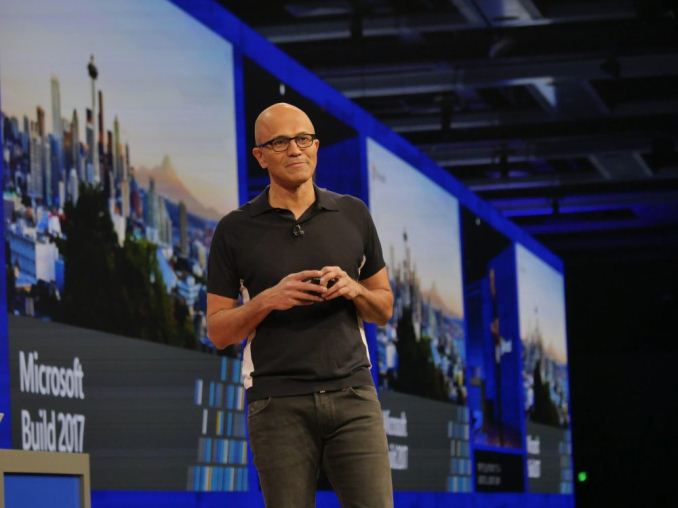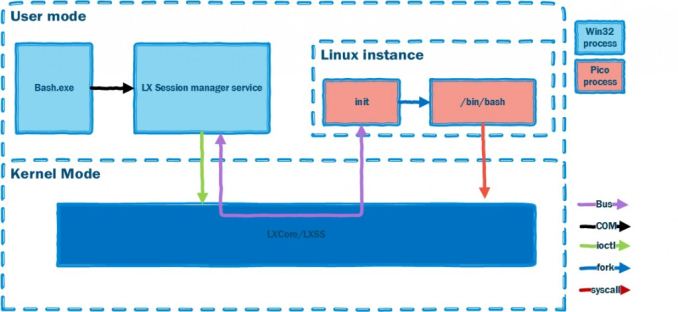The Microsoft Build 2017 Recap: What To Expect When You’re Expecting Windows
by Brett Howse on May 19, 2017 8:00 AM EST
Microsoft’s Build conference is one of their most important shows of the year, with a developer focused discussion that provides some guidance on the direction of Microsoft and its platforms. Over the last couple of years, the platforms have been some of the bigger talking points as well, with Microsoft diversifying across new technologies and markets to try and stay ahead of the curve. Microsoft has predominantly been a platform company over the years, and it’s a rare product they release that doesn’t end up as a platform of some kind. Over the years, the focus on some platforms has had to adjust in order to keep up with the times, and that’s not always an easy goal to accomplish when your original platform, Windows, has been so successful since its inception.
Microsoft had quite a bit of forward leaning news to announce at Build, which we will go over to shed some light on where the company is heading. The company has changed course with their mobile platform never gaining the traction they hoped, and although they have been very successful building out their cloud platforms, for many it’s the consumer facing products that are the most interesting.
Windows 10 Fall Creators Update
Possibly some of the biggest news about Windows actually got announced on April 20, when Microsoft committed to biannual updates for their operating system. This was a welcome announcement, and while some people would argue that it is still too often, when such a large portion of their install base is business, the almost random update interval that came with Windows 10 was unsustainable. IT needs a chance to schedule testing and deployment, and when you have randomly scheduled semi-major updates to the OS, that can be a burden. Having it set in stone for spring and fall should be a much more manageable process, especially since Windows Update for Business will allow them to defer if necessary.
The first big news was a name for the next update to Windows 10, which Microsoft is calling the Fall Creators Update. Perhaps that means the Creators Update should be prefixed with Spring, but the release date and announcement was not unexpected. After the Creators Update arrived with less major changes, and more smaller updates, perhaps there was an expectation that Windows 10 would move to more smaller updates, but the Fall Creators Update looks to be packed with new features.
With the Fall update, Microsoft is looking to refresh the experience again. They are introducing a new experience called Fluent Design, and it appears to be a solid overhaul of the design language for Windows.
Microsoft is also looking to branch out beyond their platform in new ways, with a big push for Cortana and the Microsoft Graph to enable portable experiences across platforms. It’s a smart play when you consider what happened with mobile, and all powered by the cloud.
The Windows Store got a lot of attention, and arguably it’s the part of Windows 10 that needs the most work, especially with the announcement of Windows 10 S where only Store apps will be able to be installed. The Desktop Bridge for Windows has some interesting new customers, and UWP got a lot more API support.
The big surprise at last year’s Build conference was arguable the introduction of the Windows Subsystem for Linux, and that got some more discussion at this conference as well. That, coupled with the new development tools, makes Windows a powerful development platform for much more than just Windows.
As always, it was a busy conference, with plenty of announcements. It’s always exciting to see where the different tech companies try to move the industry, and in what they prioritize in any given year, so let’s dig into the Build conference.













85 Comments
View All Comments
Kevin G - Tuesday, May 23, 2017 - link
Not sure that is true anymore (it certainly was in the past). This have changed with 10 bit and HDR becoming consumer technologies now.CSMR - Saturday, May 20, 2017 - link
"Windows has never had a color management system to speak of"The current color management system dates back to Windows Vista and Microsoft imaging applications did a good job, with some exceptions including Internet Explorer/Edge. Win10 even does a reasonable job by default, with default monitor profiles loaded automatically.
Brett Howse - Saturday, May 20, 2017 - link
It's hard to give Windows credit for color management when all of the burden is put on the developer to do all the work. That's the case right now with wide color and HDR too but doesn't appear to be the long term goal.ironwing - Sunday, May 21, 2017 - link
"Possibly some of the biggest news about Windows actually got announced on April 20, when Microsoft committed to biannual updates for their operating system."Should be "semiannual".
Brett Howse - Sunday, May 21, 2017 - link
Definition of semi-annual: occurring every six months or twice a year
Definition of biannual
: occurring twice a year
ironwing - Sunday, May 21, 2017 - link
Oops, I was reading biennial. My bad, carry on.sorten - Sunday, May 21, 2017 - link
When I saw the Google IO live coverage I was wondering if you were going to mention Build from the previous week.zepi - Monday, May 22, 2017 - link
I think one remaining issue with using Windows is the complexity of licensing in business use. Buying individual license for personal usage is simple enough, but licensing models for server versions are still a dark art.If I were a manager making decision on whether we should use Windows or Linux as a OS under our application platform, I'd be worried that costs are very opaque and I have hard time understanding the licensing. Now, obviously one doesn't just do a decision like that and .net being open sourced and usable on linux these caveats have reduced somewhat, but the underlying issue is still there.
I suppose MS thinks that azure solves this by providing a simple monthly rolling cost that abstracts everything into a one monthly bill...
doggface - Monday, May 22, 2017 - link
You are forgetting enterprise.The thing windows does very well is scale. For example, If you want to deploy an app to 5000 PCs you can click a few buttons and it is done.
If you want to block behaviour, you can do it using GPOs.
No other platform has that control.
doggface - Monday, May 22, 2017 - link
I think we can all agree you have control issues.